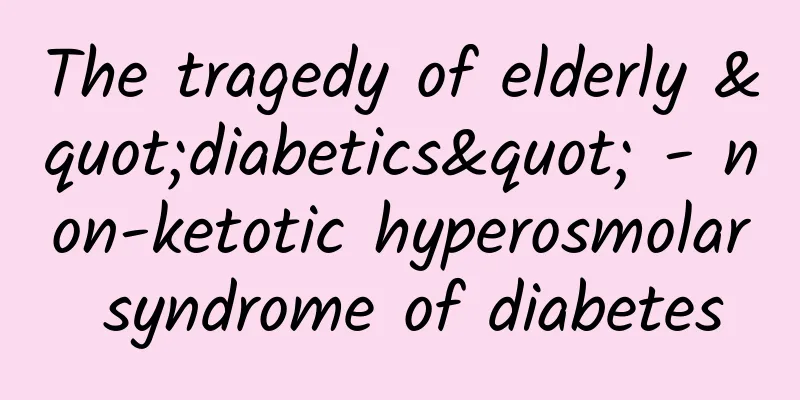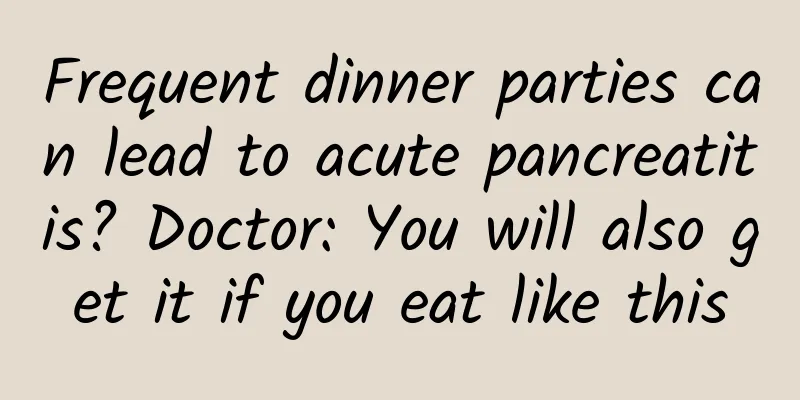The tragedy of elderly "diabetics" - non-ketotic hyperosmolar syndrome of diabetes

|
Author: Chen Ruihua, deputy chief physician, Shanghai First People's Hospital Reviewer: Xu Huanbai, Chief Physician, Shanghai First People's Hospital One summer day, a neighbor found that 75-year-old Zhang did not come downstairs as usual. He knocked on the door but no one answered the phone. The old neighbor hurriedly contacted his son. When he opened the door, he saw Zhang lying on the bed unconscious in the stuffy room. He quickly called "120". When the emergency personnel arrived, they learned that Zhang had diabetes and immediately tested his blood sugar. It turned out to be "HI" (high) and could not be measured (Figure 1). He was immediately sent to the emergency room of the hospital, and it was found that the venous blood sugar rose to 35 mmol/L, and the blood sodium level was as high as 154 mmol/L (normal is 135-145 mmol/L). After active rescue, Zhang finally woke up. After asking, I learned that Zhang had diabetes for many years, and he had been taking medicine irregularly and not monitoring his blood sugar. It was hot recently, and he was reluctant to turn on the fan and air conditioner at home because he always liked to go to the toilet at night and dared not drink more water. In the past few days, he felt more and more listless, weak, and had a poor appetite, but he was afraid of trouble and did not go to the doctor. Finally, he fell down on this day. The family members were puzzled. Why did he suddenly collapse when he was fine two days ago? The doctor told the family members that Zhang had developed a serious acute complication of diabetes - non-ketotic hyperosmolar diabetic syndrome. 1. What is diabetic nonketotic hyperosmolar syndrome? Nonketotic hyperosmolar syndrome of diabetes[1], also known as hyperosmolar hyperglycemic state[2], refers to a clinical syndrome in which diabetic patients have a significant lack of insulin secretion due to various factors, resulting in hyperglycemia causing plasma hyperosmolar dehydration and progressive impaired consciousness. It is more common in middle-aged and elderly people, and the peak season is the hot summer. The normal blood sodium level of a normal person is 135-145 mmol/L, and the plasma osmotic pressure is 280-310 msom/L, while the blood sodium level of a patient with hyperosmolar dehydration will be above 145 mmol/L, and the plasma osmotic pressure will be as high as 320 msom/L or above[2]. The main manifestations are as follows: ① "Three more and one less" symptoms: early thirst, polyuria, fatigue, aggravated loss of appetite, and gradually obvious thirst and polyuria; ② Hyperosmotic dehydration symptoms: thirst, chapped lips and tongue, dry skin, poor elasticity, sunken eyeballs, oliguria, etc.; ③ Insufficient blood volume: accelerated heartbeat, low blood pressure and even shock, etc.; ④ Neuropsychiatric symptoms: depending on the severity of the disease, slow reaction, indifferent expression, hallucinations, aphasia, confusion, drowsiness, coma, etc. gradually appear. Figure 1 Copyright image, no permission to reprint Because the elderly are insensitive to thirst and are easily lost in the hot summer, if they are not replenished with water in time, hypertonic dehydration is very likely to occur. If accompanied by increased blood sugar, coma is very likely to occur. Once coma occurs, there is a risk of death. This is mainly because the elderly often have other underlying diseases and are prone to cardiovascular and cerebrovascular complications during treatment. Therefore, timely and standardized treatment is crucial! The treatment of hyperosmolar hyperglycemia is a race against time. As long as you find that the elderly with diabetes at home are unwilling to eat, have a dull expression, slow reaction, and random blood sugar is higher than 20 mmol/L, you need to go to the emergency room immediately. During the treatment, you must actively cooperate with the doctor's treatment. Failure to cooperate may cause the patient's treatment opportunity to be lost. For example, if an elderly person is unable to drink water after falling into a coma, or is awake but unwilling to drink water, the doctor will insert a gastric tube into the patient to replenish water through fluid replacement. However, this "insertion of a tube to get water" method is often rejected by some family members as "too uncomfortable and unbearable", who do not know that this is a treatment with less harm and greater benefits. Because too much intravenous fluid replacement will increase the risk of heart failure in the elderly, and the gastric tube is made of soft rubber and is not easy to cause trauma. It enters the stomach through the natural channel of the human body, and the water infused puts much less burden on the heart than intravenous fluid replacement. Nasogastric nutrition can also be performed, which helps to restore intestinal function early. In addition, during treatment, doctors first use saline and insulin to lower blood sugar. When blood sugar drops to 16.7 mmol/L, they switch to glucose water plus insulin for fluid replacement. At this time, some family members may not understand, "Our blood sugar is already so high, and we are still using sugar? Are we making things worse?" In fact, when blood sugar is too high, insulin is used to lower it, but the speed should not be too fast. It is best to reduce it by no more than 5.6 mmol/L per hour, otherwise cerebral edema is likely to occur. When blood sugar drops, glucose needs to be supplemented to maintain the body's necessary energy supply [2]. How to find a balance between treating diabetic complications and maintaining the body's necessary energy is the technique of endocrinologists holding glucose and insulin and "walking on a tightrope on the cliff"! Figure 2 Copyright image, no permission to reprint 2. Prevention of diabetic nonketotic hyperosmolar syndrome Of course, "the best doctor treats the disease before it occurs, the middle doctor treats the disease before it occurs, and the worst doctor treats the disease after it occurs". For any serious disease, the most important thing is not to rescue it, but to prevent it. The disease should be controlled in the budding and developing stages. To prevent non-ketotic hyperosmolar diabetic syndrome, patients and their families need to pay attention to the following points: Figure 3 Copyright image, no permission to reprint 1. Keep a blood glucose meter at home, monitor blood glucose regularly and keep blood glucose stable; 2. Control your diet, do not overeat, drink water regularly, and do not drink less water for fear of going to the toilet more often; 3. When it is hot, turn on the fan and air conditioner to avoid excessive water loss due to sweating; 4. If elderly people in the family show symptoms such as loss of appetite, listlessness, dry mouth and tongue, sunken eye sockets, etc., family members should send them to the doctor in time. "An old person in the family is like a treasure." Elderly people with diabetes need more attention and care. This care is not only reflected in feeding them well and dressing them well, but also in caring for their health. Suggestions for elderly people with diabetes in the family: "Diabetics" should not save electricity in summer, as high sugar and high osmotic pressure are prone to occur; Infection and stress are the causes, and fatigue and dehydration are the manifestations. Timely discovery and prompt medical attention are the most important factors to reduce blood sugar and replenish water; Protect your heart and brain while replenishing potassium, and active treatment can help you escape danger! References Chen Jialun. Clinical Endocrinology[M]. Shanghai: Shanghai Science and Technology Press, 2011:1111-1113. Chinese Medical Association Diabetes Branch. Guidelines for the prevention and treatment of type 2 diabetes in China (2020 edition)[J]. Chinese Journal of Diabetes, 2021, 13(4): 315-409. |
<<: World Mental Health Day | How many of these common rumors about mental illness do you believe?
>>: Understand the kidneys and detect kidney cancer early
Recommend
What does it mean if the vaginal discharge is brown one month after giving birth?
Mothers need adequate rest within one month after...
What is the best time for women to soak their feet at night?
Foot soaking is a common lifestyle habit. In orde...
Is it serious if a woman has 10 white blood cells in her urine?
Abnormal white blood cells in the urine of female...
The main symptoms of chronic cervicitis
Chronic cervicitis is a common gynecological dise...
Is it easy to get pregnant on the last day of menstruation?
In fact, many people around us think that they wi...
Treatment of heavy menstrual flow after childbirth
We all know that each of us comes into this world...
Can I get pregnant two days after my period?
Many women who do not want to have children but h...
Benefits and changes after IUD removal
The IUD can effectively play the role of contrace...
What to do if you have a "double positive"? Authoritative answers
Recently, some people have tested positive for CO...
What is the best way to wash a car? What does it mean to wash a car with two buckets of water?
Cars need to be cleaned regularly, but the method...
What causes leucorrhea and low back pain?
If there is excessive vaginal discharge or it is ...
The 7 most nourishing bedtime habits for women
After a day's work, my body feels tired and I...
What should you pay attention to after taking medicine for abortion
If a woman does not want a baby after getting pre...
Can I get pregnant if I have sex three days after my period ends?
Logically speaking, you should not get pregnant i...
What to do if a woman's vagina becomes loose after giving birth
The arrival of a newborn brings countless joys to...








![[Popular Science Health Exercises] Massage experts teach you 8 exercises to nourish the lungs, replenish qi and strengthen the body. Practice them now](/upload/images/67f1eb7e6f7b4.webp)
